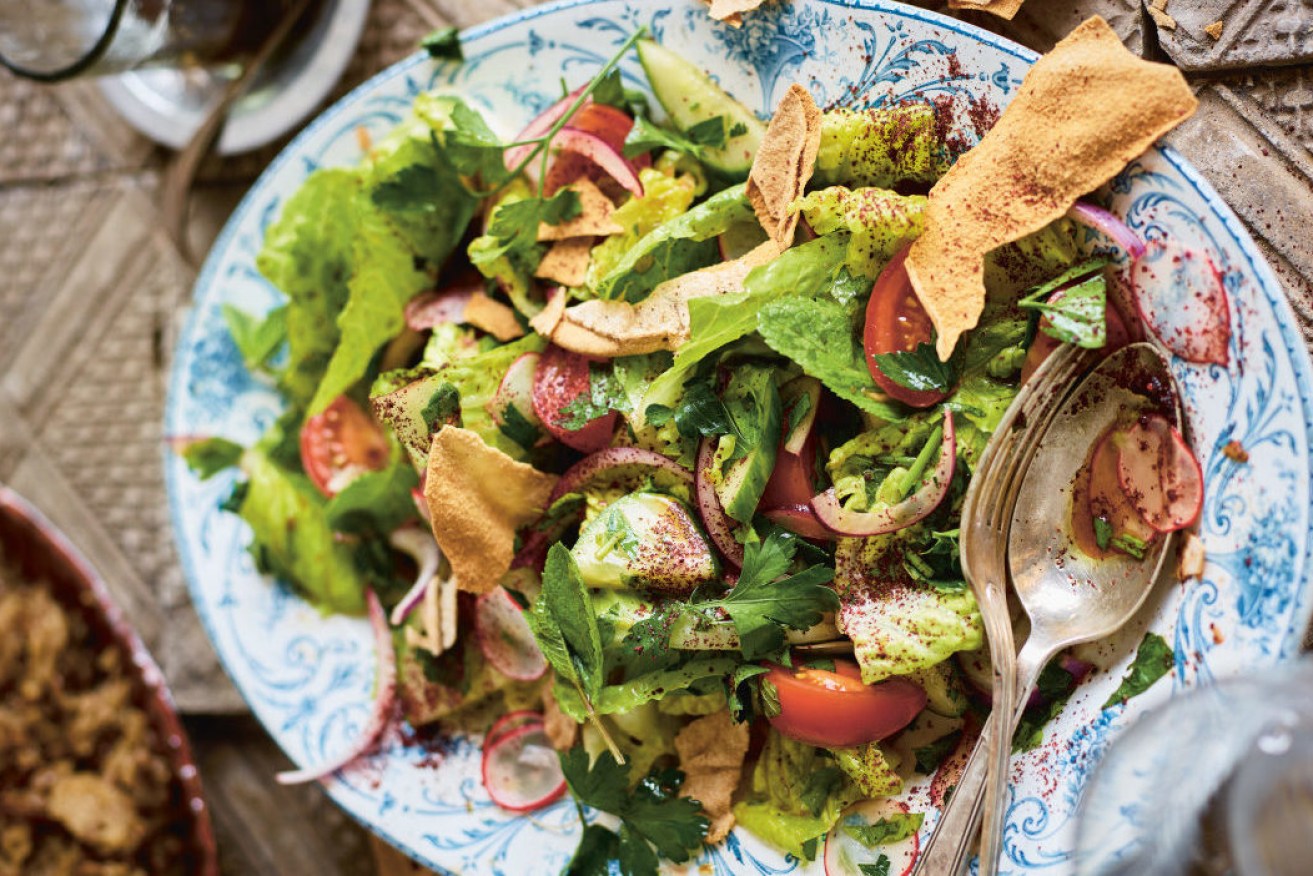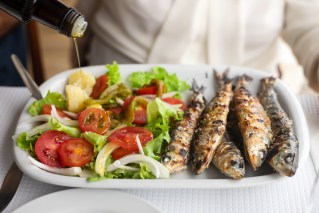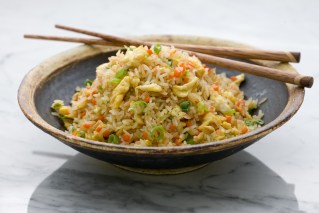Sumac: Try Anas Atassi’s delicious fattoush and ‘forgotten date cake’ recipes

Fattoush is a delicious, popular dish in Syrian cuisine. Photo: Jeroen van der Spek
Anas Atassi’s new cook book Sumac features recipes inspired by family recipes and travels, as well as the stories, celebrations and memories of loved ones in Syria that inspired the recipes.
It includes the wonderful Friday breakfasts he’d eat in his grandmother’s garden, his mother’s sfeeha, along with the falafel he now loves to make for his friends, along with many other mezze, salads, meats, vegetables, and desserts.
Fattoush
Serves 4
This is a well-known dish in Syrian cuisine. There is no single ‘real’ way to prepare it, nor does the dish have a fixed ingredient list. It’s improvisational and as simple as chopping up some vegetables and serving them with a dressing. That’s it. It’s the toasted flatbread on top that makes it a fattoush. Despite its variability, this dish tastes, like none other. It tastes like Syria, like the earth, like the local and the regional. It tastes like a hundred stories. A beautiful dish.
Ingredients
1 head of romaine lettuce (washed and cut up into large pieces)
½ of a small cucumber (chopped)
3 medium tomatoes (chopped)
3 radishes (thinly sliced)
1 red onion (halved and sliced into thin rings)
1 bunch of flat-leaf parsley (washed and coarsely chopped)
1 bunch of mint (washed and coarsely chopped)
1 flatbread (toasted and torn into pieces)
For the dressing
1 garlic clove (pressed)
Juice of 1 organic lemon
2 tablespoons of white wine vinegar
1 tablespoons of pomegranate molasses
100 ml (3½ fl oz) good quality extra-virgin olive oil
Salt to taste
2 teaspoons of sumac
In a small bowl, use a fork to whisk together all the dressing ingredients except the sumac.
In a large bowl, and using clean hands, toss all the salad ingredients except the flatbread pieces. Add the dressing, 1 tablespoon of the sumac, and toss. Let the salad rest to meld the flavours.
Before serving, arrange the toasted flatbread croutons
over the salad and sprinkle the other tablespoon of sumac over the entire dish.
Tip: In Syria, purslane is often used in fattoush. If you can’t find purslane, romaine lettuce is a tasty alternative.
Forgotten date cake
Serves 8
This recipe is my mother’s invention and is truly a fusion dish, thanks to the dates that are ubiquitous in Saudi cuisine. When I asked my mother for the recipe, she didn’t even remember having made this cake. She was convinced that it was one of her friends’ recipes! It was only after a friend found a recipe from decades ago, written in my mother’s penmanship, that she believed that this recipe was hers. Perfect for coffee or dessert.

Forgotten date cake. Photo: Jeroen van der Spek
Ingredients
225 ml (8 oz) of boiling water
200 g (1⅓ cups) of soft dates (pitted)
2 eggs
125 ml (4½ fl oz) of vegetable oil
50 ml (2½ tablespoons) of milk
1 teaspoon of vanilla extract
50 g (¼ cup) of brown sugar
250 g (1⅔ cups) of plain (all-purpose) flour
1 teaspoon of cinnamon
1 teaspoon of baking powder
1 teaspoon of bicarbonate of soda (baking soda)
For the caramel sauce
200 g (1 scant cup) sugar
3 tablespoons of butter
125 ml (4½ oz) of heavy (whipping) cream
½ teaspoon of salt
Food processor or blender
Hand mixer
Round springform or metal cake pan
Preheat the oven to 180°C (350°F).
In a heat-proof bowl, pour the boiling water over the dates. The dates should be completely covered. Soak for 15 minutes.
In a food processor, blend the dates and the soaking water for 30 seconds, or until the dates are in tiny pieces. The texture should not be completely smooth.
With a hand mixer, beat together the eggs, oil, milk, vanilla extract and brown sugar for 2-3 minutes until well combined, light in colour and fluffy.
With a rubber spatula, fold the date pieces in carefully to the egg mixture. Sift the flour, cinnamon, baking powder and bicarbonate of soda in a separate bowl and then fold into the egg mixture.
Line the bottom and sides of the cake pan with baking paper. Pour the batter into the pan and bake for 30 minutes in the middle of the oven.
While the cake is baking, make the caramel. In a large non-stick pan, heat the sugar on medium heat. The sugar will melt and start to caramelise. Do not touch or stir the sugar. It will begin to melt where it touches the sides of the pan. Now you can carefully let the sugar bead up and swirl around in the pan.
Add the butter when the sugar starts to become liquid and golden-brown. The caramel will start to bubble and spatter. Do not stand too close!
Stir the caramel with a wooden spoon until the butter is completely melted and then pour the cream in, stirring constantly. Continue cooking the caramel for 2-3 minutes to thicken it. When the caramel starts to coat the back of the spoon, add the salt. Stir and take the pan off the heat so that the caramel can cool.
Take the cake out of the oven and cool for at least 30 minutes before taking it out of the cake pan.
Place the cooled cake on a cake stand and drizzle with the caramel sauce.
Images and text from Sumac by Anas Atassi, food photography by Jeroen van der Spek. Murdoch Books RRP $49.99.








